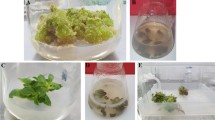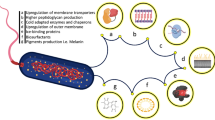Abstract
Chromium is a significant mutagen and carcinogen in environment. We compared the effects of tri- and hexavalent chromium on cytotoxicity and oxidative stress in yeast. Cell growth was inhibited by Cr3+ or Cr6+, and Cr6+ significantly increased the lethal rate compared with Cr3+. Both Cr3+ and Cr6+ can enter into the yeast cells. The percent of propidium iodide permeable cells treated with Cr3+ is almost five times as that treated with the same concentration of Cr6+. Levels of TBARS, O2 −, and carbonyl protein were significantly increased in both Cr6+- and Cr3+-treated cells in a concentration- and time-dependent manner. Moreover, the accumulation of these stress markers in Cr6+-treated cells was over the Cr3+-treated ones. The decreased GSH level and increased activity of GPx were observed after 300 μM Cr6+-exposure compared with the untreated control, whereas there was no other change of GSH content in cells treated with Cr3+ even at very high concentration. Exposure to both Cr3+ and Cr6+ resulted in the decrease of activities of SOD and catalase. Furthermore, the effect of Cr6+ is stronger than that of Cr3+. Null mutation sensitivity assay demonstrated that the gsh1 mutant was sensitive to Cr6+ other than Cr3+, the apn1 mutant is more sensitive to Cr6+ than Cr3+, and the rad1 mutant is sensitive to both Cr6+ and Cr3+. Therefore, Cr3+ can be concluded to inhibit cell growth probably due to the damage of plasma membrane integrality in yeast. Although both tri- and hexavalent chromium can induce cytotoxicity and oxidative stress, the action mode of Cr3+ is different from that of Cr6+, and serious membrane damage caused by Cr3+ is not the direct consequence of the increase of lipid peroxidation.





Similar content being viewed by others
References
Ahmad I, Maria VL, Oliveira M, Pacheco M, Santos MA (2006) Oxidative stress and genotoxic effects in gill and kidney of Anguilla anguilla L. exposed to chromium with or without pre-exposure to β-naphthoflavone. Mutat Res 608:16–28
Azad N, Iyer AK, Manosroi A, Wang L, Rojanasakul Y (2008) Superoxide-mediated proteasomal degradation of Bcl-2determines cell susceptibility to Cr(VI)-induced apoptosis. Carcinogenesis 29:1538–1545
Bagchi D, Stohs SJ, Downs BW, Bagchi M, Preuss HG (2002) Cytotoxicity and oxidative mechanisms of different forms of chromium. Toxicology 180:5–22
Barbour L, Ball LG, Zhang K, Xiao W (2006) DNA damage checkpoints are involved in postreplication repair. Genetics 174:1789–1800
Beauchamp C, Fridovich I (1971) Superoxide dismutase: improved assays and an assay applicable to acrylamide gels. Anal Biochem Rev 44:276–287
Blasiak J, Kowalik J (2000) A comparison of the in vitro genotoxicity of tri- and hexavalent chromium. Mutat Res 469:135–145
Chanet R, Izard C, Moustacchi E (1976) Genetic effects of formaldehyde in yeast. II. Influence of ploidly and of mutations affecting radiosensitivity on its lethal effect. Mutat Res 35:29–38
Costa M, Klein CB (2006) Toxicity and carcinogenicity of chromium compounds in humans. Crit Rev Toxicol 36:155–163
Deaciuc IV, D’Souza NB, Sarphie TG, Schmidt J, Hill DB, McClain CJ (1999) Effects of exogenous superoxide anion and nitric oxide on the scavenging function and electron microscopic appearance of the sinusoidal endothelium in the isolated, perfused rat liver. J Hepatol 30:213–222
Elstner EF, Heupel A (1976) Inhibition of nitrite formation from hydroxylammoniumchloride: a simple assay for superoxide dismutase. Anal Biochem 70:616–620
Goupil P, Souguir D, Ferjani E, Faure O, Hitmi A, Ledoigt G (2009) Expression of stress-related genes in tomato plants exposed to arsenic and chromium in nutrient solution. J Plant Physiol 166:1446–1452
Grant CM, MacIver FH, Dawes IW (1997) Glutathione synthetase is dispensable for growth under both normal and oxidative stress conditions in the yeast Saccharomyces cerevisiae due to an accumulation of the dipeptide gamma-glutamylcysteine. Mol Biol Cell 8:1699–1707
Hafeman DG, Sunde RA, Hoekstra WG (1974) Effect of dietary selenium on erythrocyte and liver glutathione peroxidase in the rat. J Nutr 104:580–587
Higgins DR, Prakash S, Reynolds P, Prakash L (1983) Molecular cloning and characterization of the RAD1 gene of Saccharomyces cerevisiae. Gene 26:119–126
Krumschnabel G, Nawaz M (2004) Acute toxicity of hexavalent chromium in isolated teleost hepatocytes. Aquat Toxicol 70:159–167
Ksheminska H, Fedorovych D, Babyak L, Yanovych D, Kaszycki P, Koloczek H (2005) Chromium(III) and (VI) tolerance and bioaccumulation in yeast: a survey of cellular chromium content in selected strains of representative genera. Process Biochem 40:1565–1572
Lawal AO, Ellis EM (2011) The chemopreventive effects of aged garlic extract against cadmium-induced toxicity. Environ Toxicol Pharmacol 32:266–274
Lenz AG, Costabel U, Shaltiel S, Levine RL (1989) Determination of carbonyl groups in oxidatively modified proteins by reduction with tritiated sodium borohydride. Anal Biochem 177:419–425
Luck H (1965) Catalase. In: Bergmeyer HU (ed) Methods of enzymatic analysis. Academic Press, New York, pp 885–894
Lushchak OV, Kubrak OI, Nykorak MZ, Storey KB, Lushchak VI (2008) The effect of potassium dichromate on free radical processes in goldfish: possible protective role of glutathione. Aquat Toxicol 87:108–114
Nargund AM, Avery SV, Houghton JE (2008) Cadmium induces a heterogeneous and caspase-dependent apoptotic response in Saccharomyces cerevisiae. Apoptosis 13:811–821
O’Brien TJ, Brooks BR, Patierno SR (2005) Nucleotide excision repair functions in the removal of chromium-induced DNA damage in mammalian cells. Mol Cell Biochem 279:85–95
Opperman DJ, Piater LA, van Heerden E (2008) A novel chromate reductase from Thermus scotoductus SA-01 related to old yellow enzyme. J Bacteriol 190:3076–3082
Park RM, Bena JF, Stayner LT, Smith RJ, Gibb HJ, Lees PS (2004) Hexavalent chromium and lung cancer in the chromate industry: a quantitative risk assessment. Risk Anal 24:1099–1108
Pereira Y, Lagniel G, Godat E, Baudouin-Cornu P, Junot C, Labarre J (2008) Chromate causes sulfur starvation in yeast. Toxicol Sci 106:400–412
Pourahmad J, O’Brien PJ (2001) Biological reactive intermediates that mediate chromium (VI) toxicity. Adv Exp Med Biol 500:203–207
Prakash L (1976) Effect of genes controlling radiation sensitivity on chemically induced mutations in Saccharomyces cerevisiae. Genetics 83:285–301
Puzon GJ, Tokala RK, Zhang H, Yonge D, Peyton BM, Xun L (2008) Mobility and recalcitrance of organo–chromium(III) complexes. Chemosphere 70:2054–2059
Qi W, Reiter RJ, Tan DX, Garcia JJ, Manchester LC, Karbownik M, Calvo JR (2000) Chromium(III)-induced 8-hydroxydeoxyguanosine in DNA and its reduction by antioxidants: comparative effects of melatonin, ascorbate, and vitamin E. Environ Health Perspect 108:399–402
Rossi R, Dalle-Donne I, Milzani A, Giustarini D (2005) Oxidized forms of glutathione in peripheral blood as biomarkers of oxidative stress. Clin Chem 52:1406–1414
Salnikow K, Zhitkovich A (2008) Genetic and epigenetic mechanisms in metal carcinogenesis and cocarcinogenesis: nickel, arsenic and chromium. Chem Res Toxicol 21:28–44
Shanker A, Cervantes C, Loza-Tavera H, Avudainayagam S (2005) Chromium toxicity in plants. Environ Int 31:739–753
Stout MD, Herbert RA, Kissling GE, Collins BJ, Travlos GS, Witt KL, Melnick RL, Abdo KM, Malarkey DE, Hooth MJ (2009) Hexavalent chromium is carcinogenic to F344/N rats and B6C3F1 mice after chronic oral exposure. Environ Health Perspect 117:716–722
Sumner ER, Shanmuganathan A, Sideri TC, Willetts SA, Houghton JE, Avery SV (2005) Oxidative protein damage causes chromium toxicity in yeast. Microbiology 151:1939–1948
Thompson CM, Fedorov Y, Brown DD, Suh M, Proctor DM, Kuriakose L, Haws LC, Harris MA (2012) Assessment of Cr(VI)-induced cytotoxicity and genotoxicity using high content analysis. PLoS One 7:1932–6203
Timbrell JA (1992) Principles of biochemical toxicology. Taylor & Francis, London, pp 220–222
Valko M, Morris H, Cronin MT (2005) Metals, toxicity and oxidative stress. Curr Med Chem 12:1161–1208
Wen SH, Zhang T, Tan TW (2005) Optimization of the amino acid composition in glutathione fermentation. Process Biochem 40:3474–3479
Wiegand HJ, Ottenwalder H, Bolt HM (1984) The reduction of chromium (VI) to chromium (III) by glutathione: an intracellular redox pathway in the metabolism of the carcinogen chromate. Toxicology 33:341–348
Wise SS, Holmes AL, Wise JP (2008) Hexavalent chromium-induced DNA damage and repair mechanisms. Rev Environ Health 23:39–57
Yagi K (1976) A simple fluorometric assay for lipoperoxide in blood plasma. Biochem Med 15:212–216
Acknowledgments
This study was sponsored by Grants from the National Natural Science Foundation of China (31100549), the Shanghai Pujiang Programs (10PJ1402300 & 11PJ1400100), the Innovation Program of Shanghai Municipal Education Commission (11ZZ51), the Scientific Research Foundation for the Returned Overseas Chinese Scholars, the State Education Ministry, and the Fundamental Research Funds for the Central Universities (2011D10512, WF1114020 & 222201313010).
Author information
Authors and Affiliations
Corresponding authors
Rights and permissions
About this article
Cite this article
Huang, Z., Kuang, X., Chen, Z. et al. Comparative Studies of Tri- and Hexavalent Chromium Cytotoxicity and Their Effects on Oxidative State of Saccharomyces cerevisiae Cells. Curr Microbiol 68, 448–456 (2014). https://doi.org/10.1007/s00284-013-0496-1
Received:
Accepted:
Published:
Issue Date:
DOI: https://doi.org/10.1007/s00284-013-0496-1




